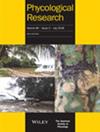圆叶球藻(Ulvophyceae)透镜状细胞的各向异性细胞生长和细胞壁结构
IF 1
4区 生物学
Q2 MARINE & FRESHWATER BIOLOGY
引用次数: 0
摘要
在巨细胞绿藻三角藻的细胞分裂过程中,新形成了一个透镜状细胞,从圆盘状生长到球状,再生长到倒卵球形。在生长的早期发育阶段,细胞表面表现出显著的向外突起。在本研究中,通过分析活细胞中表面标记物的运动,研究了细胞生长的各向异性,即细胞表面在经向和径向延伸之间的差异。细胞天顶周围的生长是各向同性的,但在其他区域有两种不同类型的各向异性生长;径向伸展在细胞外围占主导地位,经向伸展在天顶和外围之间的中间区域。此外,在透镜状细胞早期发育的不同阶段,使用原子力显微镜观察到纤维素微纤维在细胞壁内表面的局部取向。纤维素微纤维总体上显示出经向取向,这种现象在细胞的外围最为显著,这表明纤维素微纤维可能通过抑制细胞壁的经向延伸来促进细胞的径向延伸。本文章由计算机程序翻译,如有差异,请以英文原文为准。
Anisotropic cell growth and cell wall structure in lenticular cell of Valonia utricularis (Ulvophyceae)
During cell division of the giant‐celled green alga, Valonia utricularis, a lenticular cell is newly formed, which grows from disc‐shaped to globular to obovoid. During the early developmental stages of growth, the cell surface shows a remarkable outward protrusion. In the present study, the anisotropy of cell growth, i.e. the difference between cell surface extension in meridional and radial orientation, was investigated by analyzing the movement of the surface markers in a living cell. Growth was isotropic around the cell zenith but of two different kinds of anisotropic growth in other regions; radial extension was dominant in cell periphery and meridional extension in intermediate regions between zenith and periphery. Moreover, local orientation of cellulose microfibrils was observed on the inner surface of the cell wall during different stages of early development in lenticular cell using an atomic force microscope. Cellulose microfibrils showed meridional orientation overall and this phenomenon was most remarkable in the periphery of the cell, suggesting the possibility of cellulose microfibrils promoting radial extension of cells by suppressing meridional extension of cell wall.
求助全文
通过发布文献求助,成功后即可免费获取论文全文。
去求助
来源期刊

Phycological Research
生物-海洋与淡水生物学
CiteScore
3.60
自引率
13.30%
发文量
33
审稿时长
>12 weeks
期刊介绍:
Phycological Research is published by the Japanese Society of Phycology and complements the Japanese Journal of Phycology. The Journal publishes international, basic or applied, peer-reviewed research dealing with all aspects of phycology including ecology, taxonomy and phylogeny, evolution, genetics, molecular biology, biochemistry, cell biology, morphology, physiology, new techniques to facilitate the international exchange of results. All articles are peer-reviewed by at least two researchers expert in the filed of the submitted paper. Phycological Research has been credited by the International Association for Plant Taxonomy for the purpose of registration of new non-vascular plant names (including fossils).
 求助内容:
求助内容: 应助结果提醒方式:
应助结果提醒方式:


